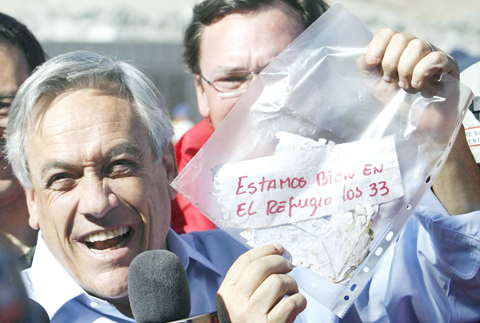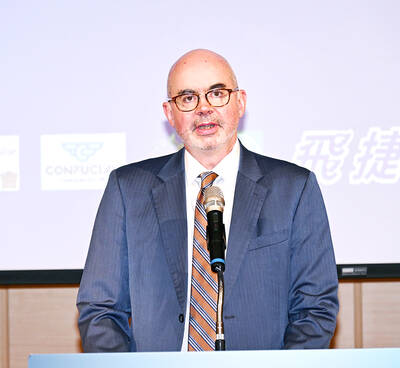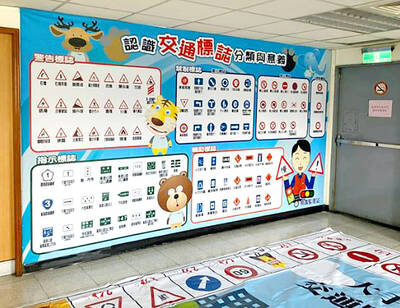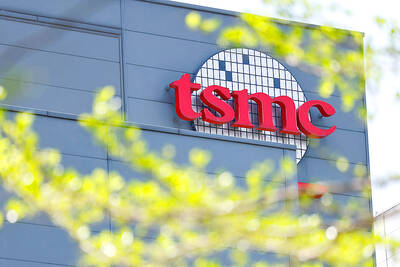Rescue workers yesterday reinforced a small drill hole to serve as an umbilical cord to 33 miners found alive 17 days after a cave-in in Chile’s far north and said it would take months to dig them out.
In what relatives dubbed a miracle, the miners on Sunday tied a note to a perforation drill that has carved a shaft the size of a grapefruit down to the refuge they are sheltered in 700m underground.
The accident in the small gold and copper mine has shone a spotlight on mine safety in Chile, the world’s No. 1 copper producer, though accidents are rare at major mines and the incident is not seen as having a significant impact on the country’s output.

PHOTO: AP
Rescue workers now plan to use the tiny bore hole to send plastic tubes containing glucose, hydration gels and food down to the miners to keep them alive while they dig a new shaft to extract them — which could take up to four months.
“What we have to do is to secure this umbilical cord to stay connected with the miners, to keep them alive,” said Andre Sougarret, manager of state copper giant Codelco’s El Teniente mine, who is heading up the drilling effort.
He said engineers would coat the sides of the bore-hole and he hoped to be able to start sending food and supplies down it yesterday morning. He said the next stage was to choose where to drill a larger hole to extract the miners without risking further cave-ins at the unstable mine.
“Our initial estimate is that it will take three to four months [to drill],” Sougarret said.
Tanks of water and ventilation shafts helped the miners to survive, but they had very limited food supplies and health officials estimate they may have lost about 8kg to 9kg each.
Rescuers lowered a television camera down the bore-hole on Sunday and some of the miners looked into the lens. Officials said they looked in better-than-expected condition.
The miners used the batteries of a truck down in the mine to charge their helmet lamps, some of which were shining in the television images.
“It will take time, but it doesn’t matter how long it takes to have a happy ending,” beaming Chilean President Sebastian Pinera said after flying to the mine on Sunday.
“This was a 17-day nightmare,” said 42-year-old miner Sandro Rojas, whose brother, two cousins and nephew are among those trapped. “When I see my brother, I’m going to tell him I love him and smother him with kisses. To be honest, I don’t know if I’ll be able to speak, I’m so excited.”

RESILIENCE: Deepening bilateral cooperation would extend the peace sustained over the 45 years since the Taiwan Relations Act, Greene said Taiwan-US relations are built on deep economic ties and shared values, American Institute in Taiwan (AIT) Director Raymond Greene said yesterday, adding that strengthening supply chain security in critical industries, enhancing societal resilience through cooperation and deepening partnerships are key to ensuring peace and stability for Taiwan in the years ahead. Greene made the remarks at the National Security Youth Forum, organized by National Taiwan University’s National Security and Strategy Studies Institution in Taipei. In his address in Mandarin Chinese, Greene said the Taiwan-US relationship is built on deep economic ties and shared interests, and grows stronger through the enduring friendship between

GAINING STEAM: The scheme initially failed to gather much attention, with only 188 cards issued in its first year, but gained popularity amid the COVID-19 pandemic Applications for the Employment Gold Card have increased in the past few years, with the card having been issued to a total of 13,191 people from 101 countries since its introduction in 2018, the National Development Council (NDC) said yesterday. Those who have received the card have included celebrities, such as former NBA star Dwight Howard and Australian-South Korean cheerleader Dahye Lee, the NDC said. The four-in-one Employment Gold Card combines a work permit, resident visa, Alien Resident Certificate (ARC) and re-entry permit. It was first introduced in February 2018 through the Act Governing Recruitment and Employment of Foreign Professionals (外國專業人才延攬及雇用法),

The Ministry of Transportation and Communications yesterday said that it would redesign the written portion of the driver’s license exam to make it more rigorous. “We hope that the exam can assess drivers’ understanding of traffic rules, particularly those who take the driver’s license test for the first time. In the past, drivers only needed to cram a book of test questions to pass the written exam,” Minister of Transportation and Communications Chen Shih-kai (陳世凱) told a news conference at the Taoyuan Motor Vehicle Office. “In the future, they would not be able to pass the test unless they study traffic regulations

EUROPEAN TARGETS: The planned Munich center would support TSMC’s European customers to design high-performance, energy-efficient chips, an executive said Taiwan Semiconductor Manufacturing Co (TSMC, 台積電), the world’s largest contract chipmaker, yesterday said that it plans to launch a new research-and-development (R&D) center in Munich, Germany, next quarter to assist customers with chip design. TSMC Europe president Paul de Bot made the announcement during a technology symposium in Amsterdam on Tuesday, the chipmaker said. The new Munich center would be the firm’s first chip designing center in Europe, it said. The chipmaker has set up a major R&D center at its base of operations in Hsinchu and plans to create a new one in the US to provide services for major US customers,